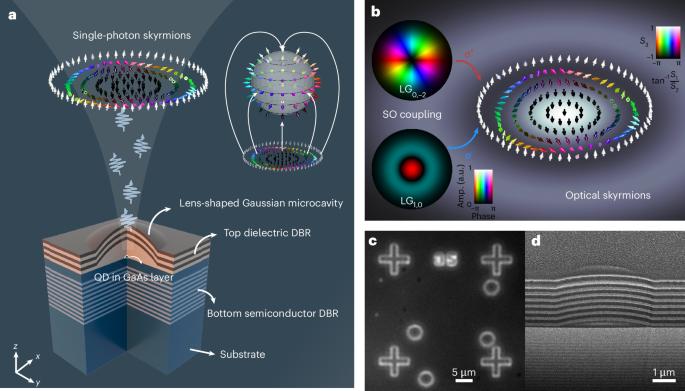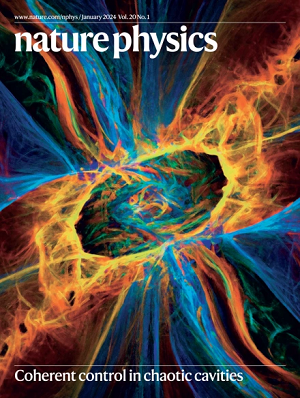Nanophotonic quantum skyrmions enabled by semiconductor cavity quantum electrodynamics
IF 18.4
1区 物理与天体物理
Q1 PHYSICS, MULTIDISCIPLINARY
引用次数: 0
Abstract
Skyrmions are topologically stable quasiparticles that have been investigated in contexts including particle physics, quantum field theory, acoustics and condensed-matter physics. Quantum optical skyrmions with local topological textures are expected to reshape the landscape of quantum photonic technology, although their experimental implementation has not yet been demonstrated. Here we present experimental realizations of nanophotonic quantum skyrmions using a semiconductor cavity quantum electrodynamics system. By manipulating the photonic spin–orbit coupling in a Gaussian microcavity, we obtained a confined optical mode whose polarizations feature skyrmionic topologies. With pronounced cavity quantum electrodynamics effects, we generated and detected single-photon skyrmions from a solid-state quantum emitter deterministically coupled to the Gaussian microcavity. The polarity associated with single-photon skyrmions can be swapped by flipping the polarization of the quantum emitter through the Zeeman effect. We also investigated the topological protection of quantum optical skyrmions under different perturbations. Our work opens an unexplored aspect of quantum light–matter interactions in the nanoscale and might advance resilient photonic quantum technology with high-dimensional qubits and high-capacity quantum memories. Quantum optical skyrmions are promising for quantum photonic applications but have not been experimentally realized. Now nanophotonic quantum skyrmions are generated using a semiconductor quantum dot–Gaussian microcavity quantum electrodynamics system.


半导体腔量子电动力学实现的纳米光子量子粒子
Skyrmions是拓扑稳定的准粒子,已经在粒子物理、量子场论、声学和凝聚态物理等领域进行了研究。具有局部拓扑结构的量子光学skyrmions有望重塑量子光子技术的格局,尽管它们的实验实现尚未得到证实。在这里,我们提出了利用半导体腔量子电动力学系统的纳米光子量子粒子的实验实现。通过对高斯微腔中光子自旋-轨道耦合的控制,我们获得了一种偏振特征为天量子拓扑的受限光学模式。利用明显的腔量子电动力学效应,我们从确定耦合到高斯微腔的固态量子发射器中产生并检测了单光子天空粒子。通过塞曼效应,可以通过翻转量子发射器的偏振来交换与单光子天空粒子相关的极性。我们还研究了不同扰动下量子光学粒子的拓扑保护。我们的工作打开了纳米尺度量子光物质相互作用的一个未被探索的方面,并可能推进具有高维量子比特和高容量量子存储器的弹性光子量子技术。
本文章由计算机程序翻译,如有差异,请以英文原文为准。
求助全文
约1分钟内获得全文
求助全文
来源期刊

Nature Physics
物理-物理:综合
CiteScore
30.40
自引率
2.00%
发文量
349
审稿时长
4-8 weeks
期刊介绍:
Nature Physics is dedicated to publishing top-tier original research in physics with a fair and rigorous review process. It provides high visibility and access to a broad readership, maintaining high standards in copy editing and production, ensuring rapid publication, and maintaining independence from academic societies and other vested interests.
The journal presents two main research paper formats: Letters and Articles. Alongside primary research, Nature Physics serves as a central source for valuable information within the physics community through Review Articles, News & Views, Research Highlights covering crucial developments across the physics literature, Commentaries, Book Reviews, and Correspondence.
 求助内容:
求助内容: 应助结果提醒方式:
应助结果提醒方式:


